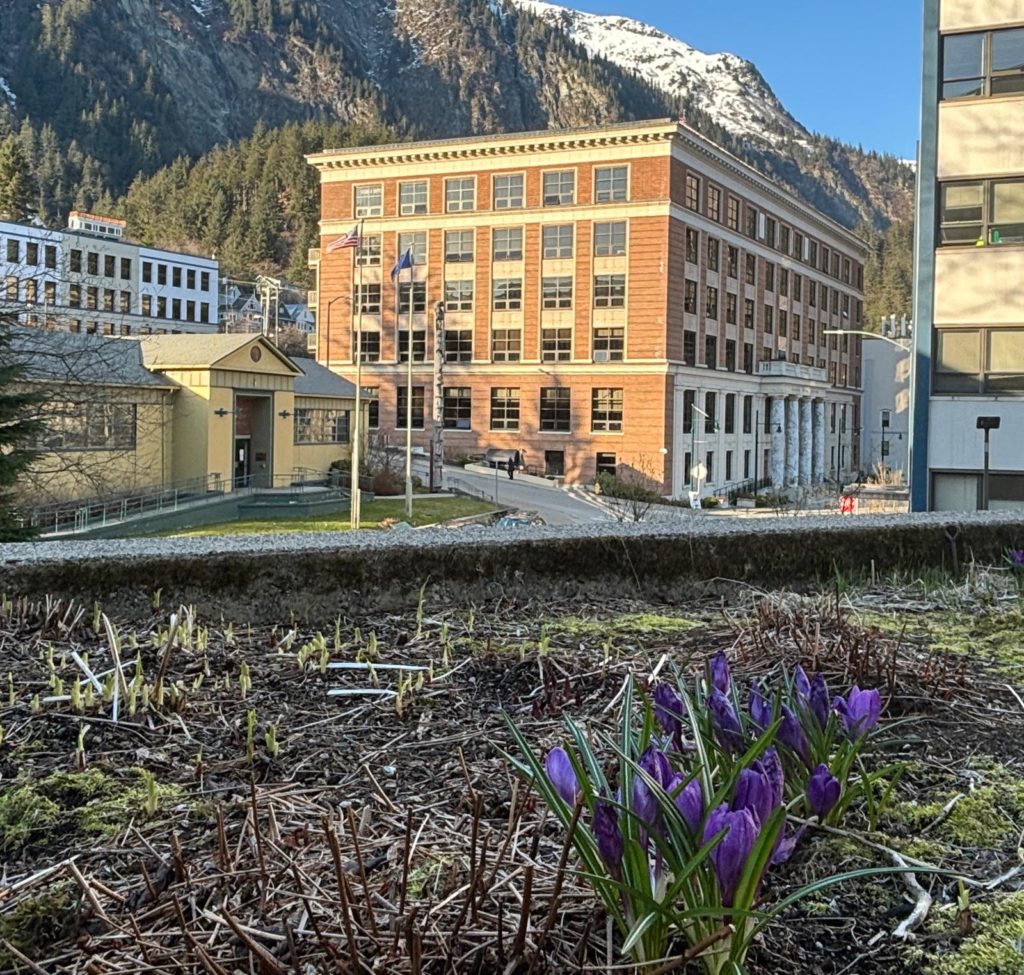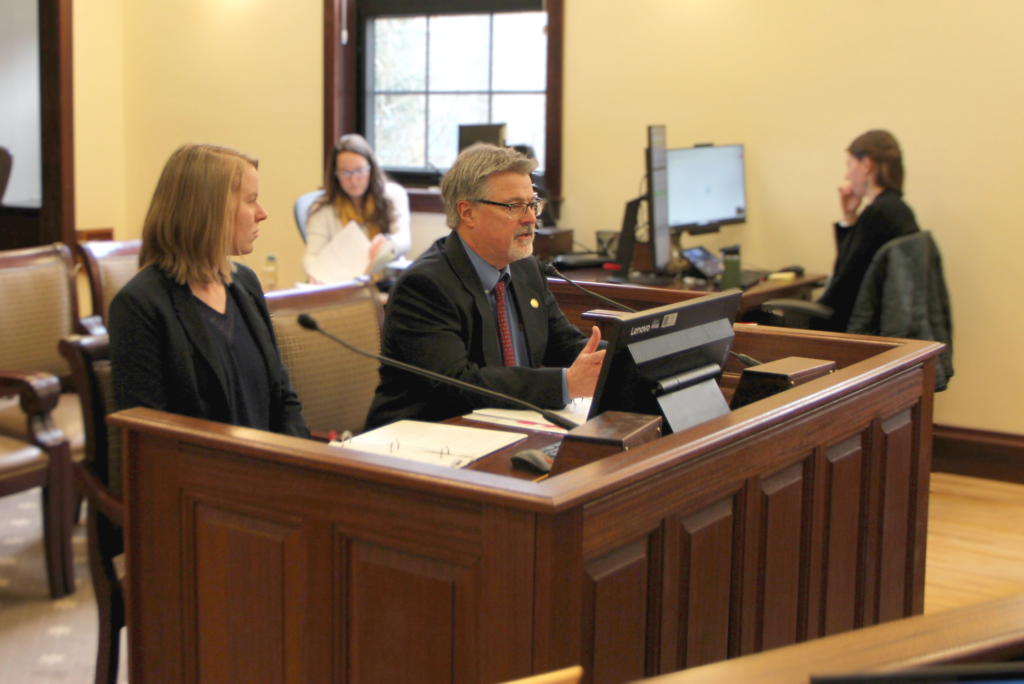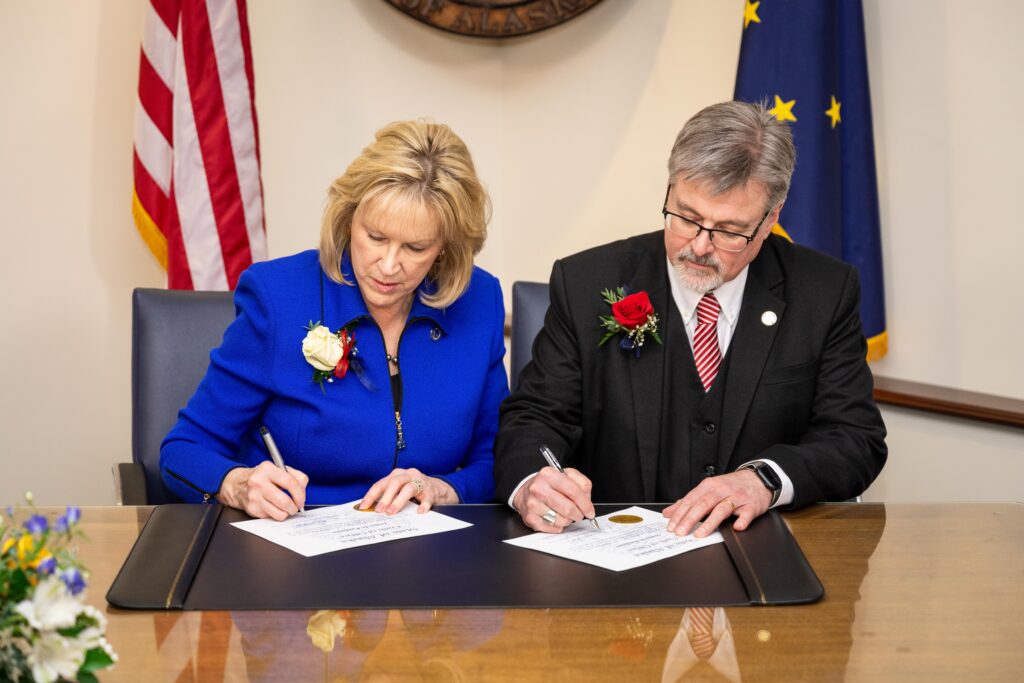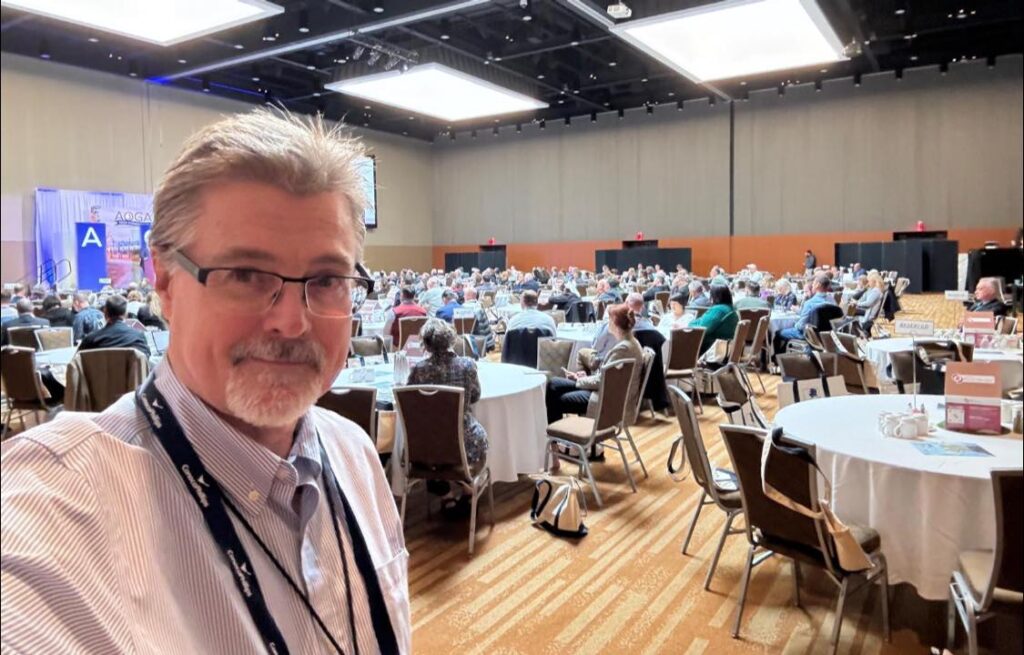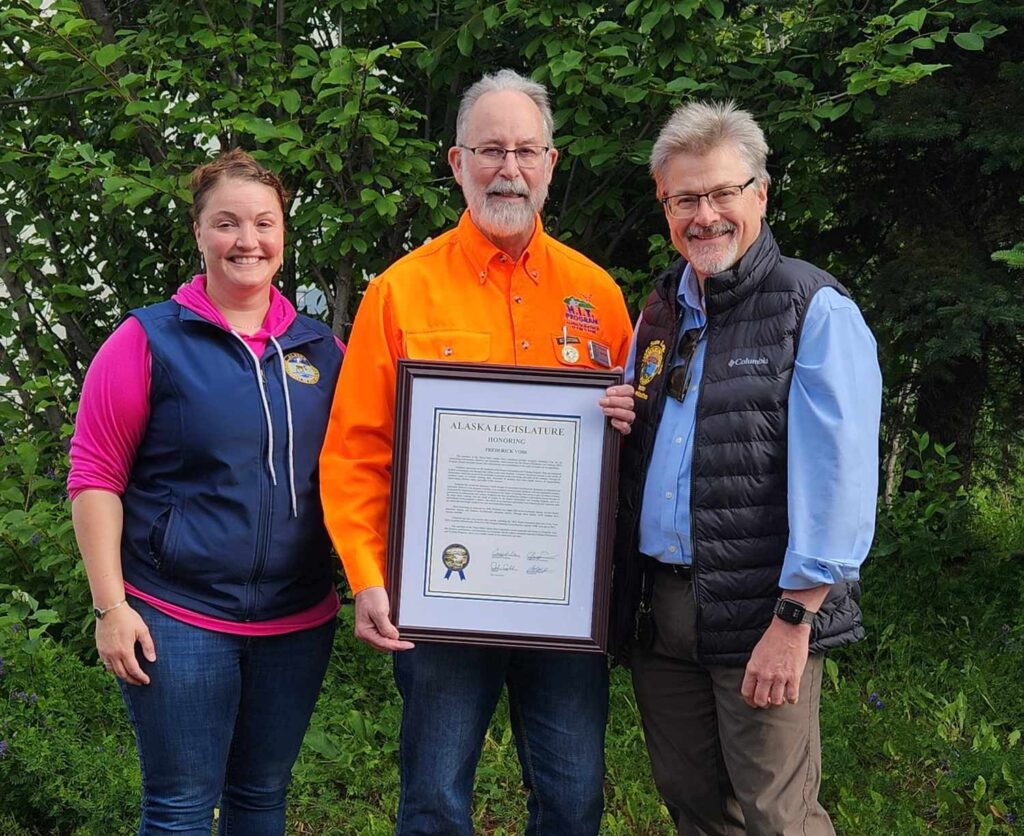We are getting to that point in the legislative session where the days are longer, the snow has mostly disappeared in Juneau, and the early blooms of crocus, daffodil, and hyacinth are popping out. We have even seen the first of many cruise ships that will visit Juneau, so the feel has shifted firmly to spring. Hopefully Anchorage will be moving in that direction soon!
Meanwhile, big topics are being addressed in every office and in both the House and the Senate chambers. A great deal of legislative work gets done every year, but this second session of the 33’d legislature has seen many big topics loudly roar to the front of the line. I truly believe that we are at a crossroads where what has worked in the past is being challenged by what need now and in the future.
We passed education funding and reform measures with SB 140 which was ultimately vetoed (after which the veto was sustained by the Legislature). Now it has been replaced by the nearly identical HB 392, which is now being considered in the House. All I can say for now is ‘stay tuned,’ I’ll be following the debate closely.
We are working to address the short-term availability of Cook Inlet natural gas (which fuels much of Southcentral Alaska). At the same time, we are looking for other suitable mid- and long-term energy sources to reduce, or hopefully avoid, future reliance on imported natural gas.
We are considering the scope and funding of critical reliability and capacity upgrades to our electrical grid, even while addressing a host of other issues affecting healthcare, transportation, and delivery of critical services.
The budget is the 800 pound gorilla to be addressed, and so far all seems to be going reasonably well, the process is moving according to the agreed upon schedule and hopefully a timely passage in just a few weeks.
Lastly, a recent court ruling has sent shockwaves through the home- and correspondence-schooling community across the state. The legislature is considering what it can do to assure that there is no significant disruption for families who have been receiving correspondence school allotments, but continued action in the higher courts is really where the immediate focus is for now, in the very short term. Looking a little farther out, legislative action will be needed to bring our statutes into compliance with the court’s final decision.
As always, there is much more information below, so take a look and let me know if you have any questions or comments!
You can call me anytime at 907-465-4949 and keep up with day-to-day things on my Facebook page.
My Bill Passes the Senate!
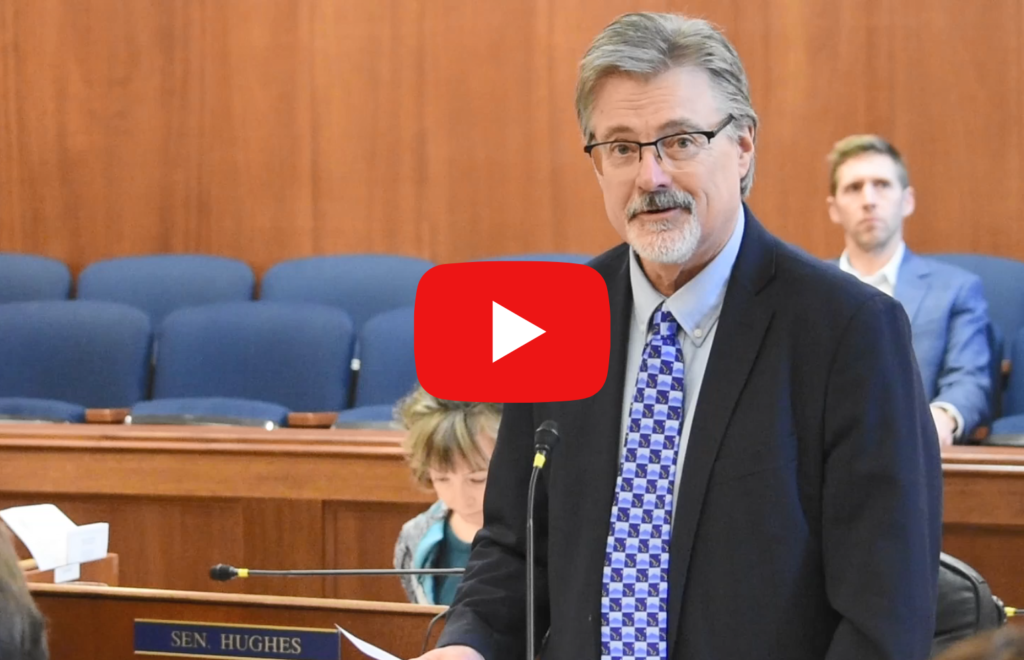
Citizens’ Advisory Commission on Federal Areas | SB 34
For decades, CACFA monitored federal actions and ensured that individual Alaskans had a place to go to understand and engage constructively with federal decisions that affect them. Senate Bill 34 seeks to reinstate the commission (after it sunset in 2021) so that it can continue to serve Alaskans. SB 34 unanimously passed the Senate at the end of March! It now has one more committee to go to before it heads to the House floor.
The Budget Process + Capital Projects
Two weeks ago, the Operating Budget passed the House and the Capital Budget passed the Senate. Now, the respective budgets have a few more steps in the process. They must both be amended by and pass their second bodies of referral and then move to conference committees, where the difference between the House and Senate versions can be reconciled and final versions can be agreed upon.
All of that to say: The versions that you may read about in various news outlets or newsletters (including this one) are not final and still have changes to go through. However, passing the first body of referral is a major step and sets the first guideline for what has a high likelihood of making it through the process. These are also large documents with a lot of information, but below is a list of some road/safety projects for District F that I was proud to get into the Senate version of the Capital Budget.
My goal this year was projects focused on school-children crossing safety to O’Malley elementary school, Service High School, and Trailside Elementary. Other top priorities included improvements to Elmore Road surrounding Abbott Loop Community Park related to pedestrian safety and car congestion. Other projects include road rehabilitation for neighborhood roads, and matching donations for recreation and park access projects. For some of these projects, more money may be required in the future, but planning money is included so that we can do the work necessary to build the case and backup documentation for these projects.
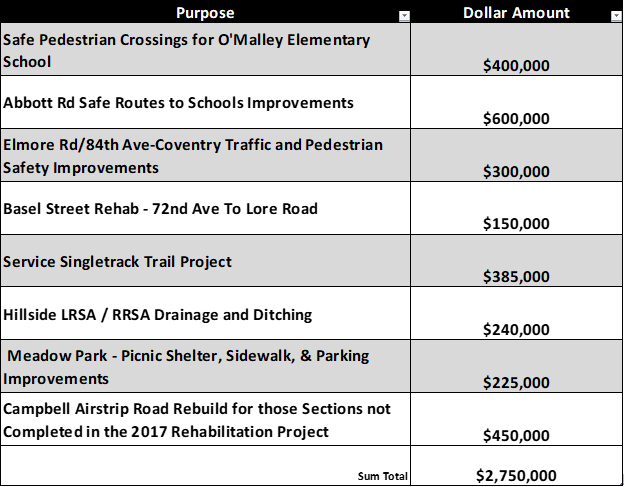
All of these projects are the top priority projects for the community councils in my district, which are a great resource for capital project input. If you’re not currently attending your local community council I highly recommend it! The main community councils in District 11 are the Hillside and Huffman/O’Malley community councils. The main community council in District 12 is Abbott Loop community council. I encourage you to visit communitycouncils.org and get engaged.
As mentioned earlier in this section, the Capital Budget still has further steps to go through, but having these projects in a budget that passed one of the bodies is still a major win. Also, I’d like to note that other projects will be ongoing in the district that are programmed through the local transportation planning processes, DOT programs, and other plans. The project list above is purely additional discretionary funding for high-priority district projects that have not been included in any other plans.
Education
Education has been such a big issue this year that I’ve written about it in almost all of my past newsletters! Here are some links to two of my more lengthy past writings on the topic.
My 1/29/24 newsletter, introduced SB 140 and this year’s education debate
My 3/6/24 newsletter discussed SB 140 after it passed the full legislature
A lot has happened since the last time I dove deep on this subject. The Governor vetoed SB 140, the legislature failed to override the Governor’s veto by one vote, the federal government designated Alaska as a high-risk grantee for education funds, and a new court decision struck down statutes governing Alaska’s correspondence programs.
SB 140 Veto and Override
Two weeks after the full legislature passed SB 140 (38-2 in the House and 18-1 in the Senate) Governor Dunleavy vetoed the bill along with the following message >>
Article 2, Section 16 of Alaska’s Constitution requires the legislature to meet and reconsider passage of the vetoed bill. In accordance with that provision, the legislature met in joint session and voted on whether or not to override the Governor’s veto, which requires a 2/3 majority (or 40 votes of the full legislature). The override vote failed by one vote with a final tally of 39 votes to override and 20 votes to sustain the veto.
I voted to override the veto. I wrote about SB 140’s provisions in my newsletter (linked above) and right before the vote, I spoke about my thoughts on this bill and other education policies, you can watch it here >>
As I said in my speech, while the provisions in SB 140 were not perfect, I believed it was a needed step in the right direction that we could afford within a balanced budget.
New Education Legislation is Introduced after SB 140 is Vetoed
Around the time that the veto was sustained, a near identical replacement bill was introduced in the House (HB 392). The one difference is a new approval process for charter schools that puts approval or rejection purely in the hands of the governor-appointed state Board of Education. As of right now, a lot of the burden is on the House to come up with a product that can pass their body. Maybe HB 392 is that vehicle.
Correspondence School Court Ruling
A new wrinkle has been thrown into the mix this past week: An Alaska Superior Court ruling released on Friday, 4/12.
This court case centers around Article VII, Section 1 of our Alaska Constitution which states that, “…No money shall be paid from public funds for the direct benefit of any religious or other private educational institution.”
This constitutional provision as applied to correspondence allotments, funds which homeschool students and other correspondence students receive to pay for education material, was the focus of the court case. Correspondence allotments, in statute allowed parents of correspondence program students to spend their share of state education money on “nonsectarian services and materials from a public, private, or religious organization.” As you can see, there can be a perceived discrepancy between “Institution” and “organization”.
The decision struck down the statutes governing Alaska’s correspondence programs in their entirety. In my opinion, much too broad of a decision.
This is a huge decision that affects around 24,000 children in Alaska’s correspondence programs, which have been around since before statehood in various forms. Now, everybody is trying to figure out the best way to proceed and there are a few different lines-of-action that will be taken.
As mentioned in the letter from Commissioner Bishop to Districts, it is likely that a “stay” will be filed for and issued, meaning that the decision will not go into effect until a later time, to be determined by the court. It is also the intent of the Executive Branch to appeal the decision, which means that it would go to the Alaska Supreme Court to confirm, amend, or reverse the current decision. Now that the issue is in the Court System, that legal action must play its course. However, there are further actions that the legislature can take including refining definitions in statute, making further changes to correspondence program statutes, or considering constitutional amendments. These are listed in order based on the level of difficulty.
I firmly believe that we need a resolution to this issue this year. A recurring issue in this state is a lack of stability in many different areas, and this is yet another example. Parents need guidance and stability to plan for their students’ education next year! That’s also why I supported SB 140. One time funding equal to the BSA increase proposed in SB 140 (which increases funding to correspondence programs as well) is in the House version of the budget. But one time funding is not stable and leads to districts spending the money on one-time items, not teachers or sustainable multi-year educational assets.
One more education issue and then I’ll be done with this section of the newsletter, thanks for hanging in there!
Accountability for Federal Funds
Whenever the State of Alaska receives Federal money, it always comes with stipulations, reporting requirements, and similar restrictions. Overall, I think that accountability in how governments spend money is a good thing, but there are often difficulties associated with new requirements. When the State of Alaska received about $360 million in federal aid from the 2021 American Rescue Plan Act for pandemic-related costs a new stipulation was included. Based on that new requirement and the federal government’s calculations, Alaska’s Department of Education owes roughly $17.5 million to four districts (Anchorage, Kenai Peninsula Borough, Fairbanks North Star Borough, and Juneau). The Alaska Department of Education has so far disputed this misallocation.
As mentioned, this was a new requirement and many, many states struggled with implementation of the new requirement. In 2021, the first year, 41 states had issues meeting federal requirements. In 2022, every state but Alaska had resolved those issues. It is my understanding that the Senate plans to set aside about $15 million in case the issue is resolved and the extra school funding is needed.
If you have questions or would like to talk more about any of these issues, reach out! I am happy to help!
Phone: (907) 465-4949
Email: sen.james.kaufman@akleg.gov
Energy
Sometimes I feel like the term “crossroads” is overused, especially in politics, but Alaska is undeniably at the crossroads of many issues this year. Fiscal Policy, Education, and Energy are the big ones, but we’re also standing at the precipice of workforce, housing, and general economic challenges just to name a few. Unfortunately, the legislature can only focus on so many big issues at once. However, energy is still a top priority. In a past newsletter, I wrote specifically about the Cook Inlet gas shortage and necessary short-, intermediate- and long-term actions. Read that here >>
To summarize, the Railbelt, specifically the Cook Inlet region faces a significant challenge: based on current proved reserves, Cook Inlet gas will be unable to meet demand by 2027/2028. In Alaska, gas demand is fairly stable; it is unlikely to decrease significantly, even if prices rise, or to increase significantly if more gas is produced. This situation means that Alaska stakeholders must take immediate action on several fronts: enhancing Cook Inlet gas production in the short-term, considering gas imports (at as low of a level as possible) in the medium-term, and progressing a set of long-term solutions immediately due to long lead-times. The main levers to pull for producers in Cook Inlet are royalty relief, income tax relief, jack-up rig tax credits, or other incentives, and improving availability of seismic data.
The Governor has signaled intent to address the gas shortage by providing incentives to improve the economics of gas production in Cook Inlet. His proposals include reducing minimum royalties on new projects with an additional cut for the first ten years of production. However, the effectiveness of such measures remains to be seen, as a recent royalty-free lease sale yielded only a couple of bids. Alongside these proposals, the administration continues to communicate optimism about the potential for the Alaska LNG project, which would bring North Slope gas to Nikiski, although investor interest remains uncertain (Read more about that here).
In this issue, I’ll provide some more specific details about the short-term solutions. See below for short summaries of some bills that seem to have the most momentum and highest likelihood of passing this year. (This is just a selection of bills. If you have questions about bills not listed here then please reach out with questions and our office will be happy to help).
Bills Directly Addressing Energy and Cook-Inlet Focused
HB 257 by Representative McKay attempts to broaden access to state-owned seismic survey data by making state seismic survey data available to qualified persons. This bill is in the House Finance Committee and then will head to the House Floor and onto the Senate, where I will get a deeper look at the proposal.
We currently have one jack-up rig in Cook Inlet, which is a non-permanent offshore drilling rig that can be moved from location to location to drill exploration and development wells. Any new development is going to require a second jack-up rig, because the one jack-up rig is fully booked. HB 387 by the House Resources Committee provides a tax liability reduction credit equal to 100% of the cost of purchasing and transporting a jack-up rig, with a limit of $75 million. Again, the numbers could change and the bill has many more steps, but an interesting idea.
Royalty Structure changes are a major factor in making gas production more economically viable.
There are three main proposals in the House. One offered by the Governor (SB 194/HB 276, one offered by Representative Rauscher (HB 223), and one offered by the House Resources Committee (HB 393). The bills by Representative Rauscher and the House Resources Committee are both in the House Finance Committee, which is the final step before the floor. Since these bills both have a few more steps in the process, I’ll just speak more broadly about the policy proposals and the differences between the two.
HB 223 applies only to Cook Inlet, reduces the royalty on new gas to 0%, and reduces royalties on new oil by 50%. See below flowchart for a summary of this bill’s proposal.
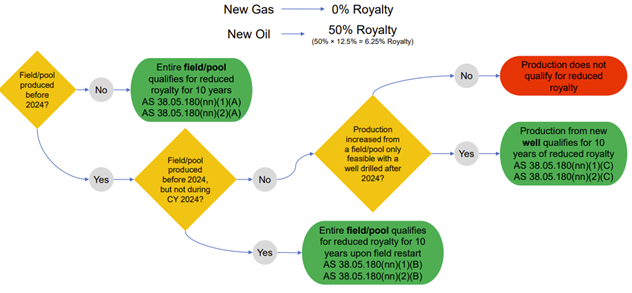
HB 393 changes the royalty structure for Cook Inlet and all fields below 68 degrees North Latitude (just barely above the Arctic Circle) as follows.
0% for gas produced from new wells drilled starting in FY25
5% for oil produced from new wells drilled starting in FY25
5% on oil and gas produced from wells drilled prior to FY25
HB 393 also pins royalties to 0 if Capital Expenditures associated with development of oil or gas is being recovered in the applicable areas.
The intent of both of these bills is to make the production of Cook Inlet gas more economically viable in the short term while we make investments in longer-term solutions. There are many different ways in which these policy proposals can be tweaked, but I will have that discussion in the Senate Resources Committee when the bills pass the House and arrive in the Senate.
Other Topics
SB 152: Community Energy Facilities; Net Metering (The Community Solar Bill)
This bill just passed the Senate and is on its way to the House. It establishes a program that would allow individuals to receive credits on their utility bills if they purchase a “subscription” or buy-in to power generation from a single centralized and efficient renewable energy source. This subscription allows homeowners and tenants who might not have access to consistent solar or renewable energy sources to reap the benefits of cost savings, reliability, and other benefits to the community.
SB 217: “Integrated Transmission Systems”
This bill has changed significantly recently and includes a few main provisions.
It levels the taxation playing field for Independent Power Producers (IPPs) who sell their power to non-profit electric utilities, reducing delays in project development and ensuring taxes on IPPs don’t get passed through to consumers.
The statutes applying to electric reliability organizations (EROs) are amended to include a focus on cost of the consumer alongside reliability and stability of generation infrastructure.
Railbelt Transmission Organization (RTO) is created under Alaska Energy Authority (AEA) and defined to provide integrated transmission planning.
The bill allows RCA to increase its surcharge slightly to help fund its operations
The AIDEA and AEA boards are currently the same, this bill creates a separate board for AEA and sets the purpose and duties of that board
There is much more detail in this bill so feel free to reach out to my office with questions and we’d be happy to walk through the proposal.
SB 220: RCA Regulate Natural Gas Storage Facilities
Currently, the Regulatory Commission of Alaska (RCA) has the authority to regulate the service of natural gas storage facilities in Alaska, but the law states that only storage facilities owned by regulated public utilities are regulated by RCA. This bill clarifies that definition.
North Slope Oil Production
While North Slope oil production has not been our main focus this year, it heavily impacts our budget process and I haven’t touched on it recently so here are a few thoughts. It seems like Alaska is right on the edge of an oil and gas renaissance with North Slope activity high and trending upwards. Major projects Pikka and Willow are moving forward and other prospects such as Quokka, Horseshoe, and Nanushuk look promising. Alaska’s Division of Oil and Gas divides forecasted production into three main categories: Current Production (CP),Under Development (UE), and Under Exploration (UE). The “Under Exploration” category is very exciting, but we know that not all of the UE listed will materialize
For more information on oil production, check out this presentation >>

As you can see from that chart, new exploration and production has the potential to not only stop the decline of Alaska oil production but to provide growth. This has direct benefits such as jobs, development of Alaska’s skilled workforce, investment attractiveness, and revenue for the state budget. Earlier this year, the revenue forecast was presented to the Senate Finance Committee. View that presentation and/or supporting documents here:
Spring Revenue Forecast here >>
I know this was a long section, but there is still much more detail that was left out. As always, reach out to my office for discussion or with questions. I am happy to help!
Visiting Huffman Elementary & South High School
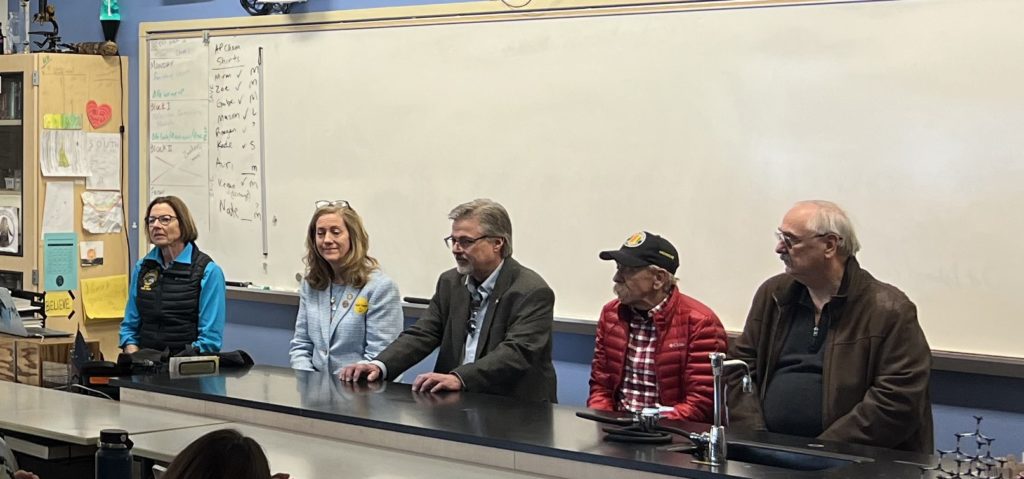
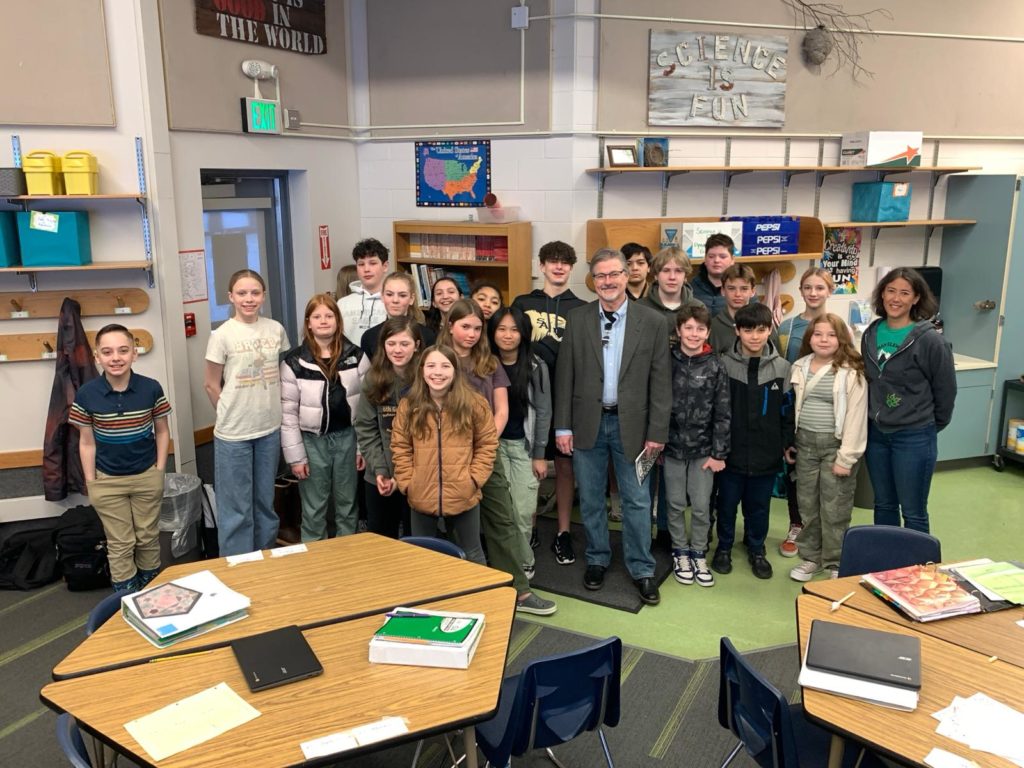
I had the chance to visit Huffman Elementary and South High School recently. I enjoyed the opportunity to hear directly from Huffman principal Molly Hickox, South principal Luke Almon, teachers, and students at both schools. It’s always good to spend time with people on the front lines of our education system. Their work is critical!
Opioid Overdoses
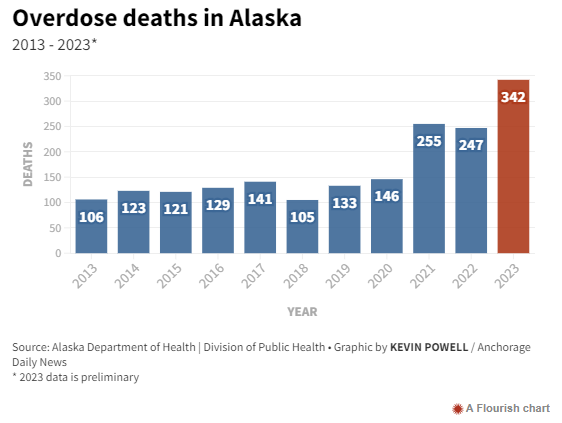
Data was recently released that is jarring and incredibly concerning. 2023 was Alaska’s deadliest year for opioid overdoses—and Alaska, with an almost 40% increase, saw the highest year-to-year increase in the nation. Much of this, but not all, is attributable to the increase of fentanyl availability.
I wanted to include this in the newsletter because I don’t want people to think that the topic is something that the legislature isn’t concerned about. It’s not lost on me that every number in that bar chart is somebody’s life.
The State of Alaska initially laid out focus areas, strategies, and actions in a Statewide Opioid Action Plan in 2018 >>
The State of Alaska also provided a report to the legislature on October 1, 2023 related to Alaska’s opioid response >>
Response to the opioid epidemic is difficult because of how dynamic and complex the issue is, made only more complex by the frequent introduction of new substances. That is not an excuse for the slow, and sometimes insufficient, actions. I am a huge advocate for planning, but we have to take action on the plans.
The federal government plays a major role, as do nonprofits and other similar organizations. The Alaska Legislature has the opportunity this year to take actions immediately as well.
HB 66 by the Governor targets the problem at the point of distribution, making it second degree murder when a person distributes or manufactures a controlled substance and a person dies as a direct result of ingesting that substance. The bill also ensures that offenders convicted of distributing or manufacturing drugs will not be subject to early release due to a “good time” deduction from their sentence. It also increases presumptive penalties for manufacturing or delivering fentanyl and methamphetamine. Currently, the bill is in the Senate Judiciary Committee and has already passed the House. A few more steps and then, in some form, the bill should move to the Senate Floor for a final vote.
HB 202 by the Representative DeLena Johnson is a bill aimed at saving student lives by requiring Alaska schools to keep opioid-overdose-reversing drugs such as naloxone on campus. This bill is moving through House Finance and then goes to the House Floor and onto the Senate.
There are also budget inclusions such as the receipt and utilization of $4.4 million in Opioid settlement funds and more. There is more, but give me a call or send me an email and I can provide more information.
Here is a link to more data regarding opioid mortality. Also, pasted below is a list of “evidence-based strategies to reduce drug overdose deaths” (source)
Prevention:
Educational campaigns.
- Interventions tailored to the community.
- Prescription drug monitoring programs.
- Opioid prescribing guidelines.
- Regulating promotion and marketing of opioids.
- Better mental health care.
- Opioid safe disposal locations.
- Harm Reduction:
- Availability of fentanyl test strips.
- Naloxone access and training.
- Syringe services programs.
- Supervised injection sites.
Treatment:
- Increase access to treatment, including through telehealth.
- Medications for opioid use disorder.
- Expand and diversify treatment workforce.
- Improve health care workforce addiction training.
- Reduce stigma for seeking care.
- Access to culturally competent care.
- Treatment alternatives to incarceration.
Recovery:
- Employment opportunities for people in recovery.
- Expanded access to recovery housing.
- Peer counseling.
- Intensive support to sustain recovery.
- Data Collection
- Promote timely collection of local data, including demographics.
- Make real-time, disaggregated data available for identifying at-risk groups.
- Use information gathered to inform effective, community tailored strategies
Hospitals and Organizations in Anchorage (and around the state) provide Opioid Overdose Rescue Kits (Narcan) for FREE. Learn where to pick one up:
Update on Road Construction Projects for this Summer (a STIP update)
Great news! Alaska’s Statewide Transportation Improvement Program (STIP) was approved on March 27th by the Federal Highway Administration (FHWA). After being initially rejected on 2/12 by FHWA, AKDOT worked around the clock to correct the issues. This approval has a few conditions, and AKDOT will be working to resolve those smaller issues in the next six months. In the meantime, our summer construction season will go forward as planned.
Now that the STIP is approved, we will be looking for ways to provide any systemic fixes that are needed so that this doesn’t happen again.
On Thursday the 11th, AKDOT came before the Senate Transportation Committee to talk about the STIP approval, to discuss their lessons learned through this process, and how they plan to ensure this does not happen again. You can watch that hearing here:
STIP Approval and the Road Forward
A Presentation by AKDOT to the Senate Transportation Committee
Watch here > | See AKDOT’s slide deck here >
For background: The STIP is the state’s four-year plan for transportation infrastructure projects. Projects both building new infrastructure and maintaining our existing assets . It includes interstate, state and some local highways, bridges, ferries and public transportation, but does not include airports or non-ferry-related ports and harbors.
As the chair of the Senate Transportation Committee, this topic is of extreme importance to me. This year and last year, we held hearings specifically focused on the planning process and STIP development (see topics and links below).
1/31/2023 Senate Transportation Committee, Federal Funding and Planning for the Future: Watch here >>
2/14/2023 Senate Transportation Committee, Strategic Investment Decisions and Transportation Planning Data: Watch here >>
8/22/2023 Joint Senate and House, Alaska’s Modern STIP: Watch here >>
2/28/2024 Senate Finance Committee, STIP Update focused on what DOT was doing to prepare for resubmitting the STIP: Watch here >>
If you are interested in learning more, AKDOT has posted a lot of information on their STIP website (including project details and all formal correspondence between FHWA and AKDOT about the corrective actions following the initial rejection):
Dig into the projects included in the STIP online here >>
Dig into the correspondence and formal documents submitted to FHWA online here >>
Anchorage Delegation Town Hall
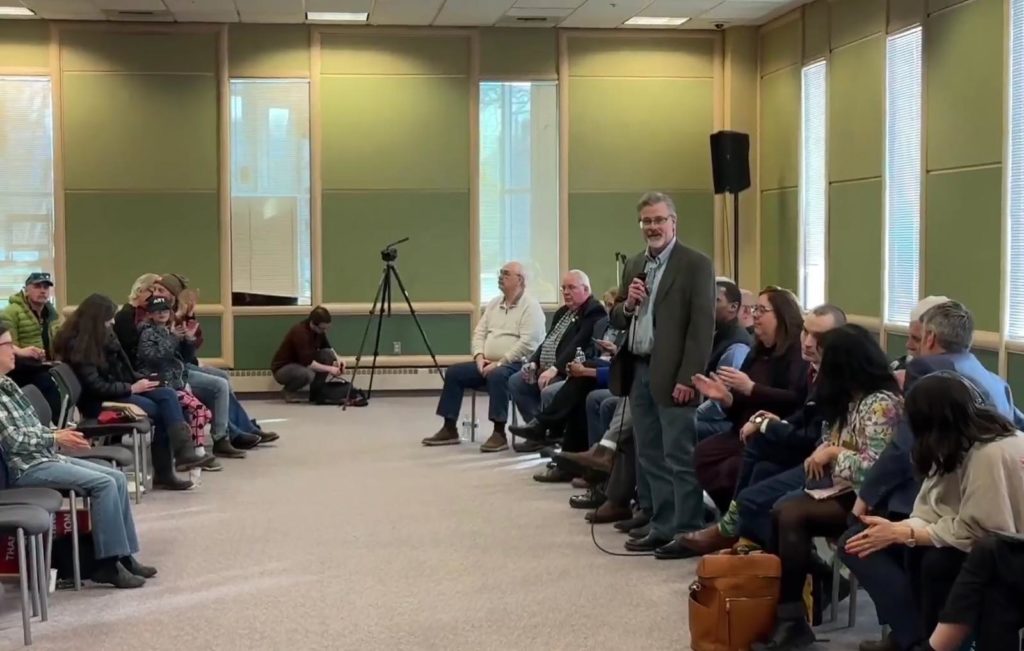
Thank you for joining me at the the Anchorage Delegation Town Hall last month. We had great conversations about education, energy, capital infrastructure projects in Anchorage, and much more. We face some big issues in Alaska and I appreciate everyone that gets involved in these discussions. It helps me represent you better!
A big thank you to Anchorage Delegation co-chair Representative Donna Mears, my colleagues, our staff, and our hosts at UAA: University of Alaska Anchorage for making this event possible!
Video of the townhall is available at my Facebook page here >>
My Bills Heard Recently:
GDP-Based Sustainable Spending | SJR 4 / SB 20
Senate Joint Resolution 4 / Senate Bill 20 is a functional state spending cap which constructively links our private sector performance (measured by GDP) and government spending. An effective limit like this one creates stability and predictability in our budgeting process – in economic boom years, extra revenues are pushed forward, preventing the need for drastic cuts in economic bust years. SB 20/SJR 4 was recently heard in the Senate Judiciary Committee. The spending limit is set based on a certain percentage of Alaska’s private sector economic performance. Specifically, we use the Real GDP of Alaska minus government spending. As you can see below, this wouldn’t be a harsh cut or cap, but rather a smoothing mechanism that ebbs and flows with Alaska’s economy, preventing the boom and bust spending cycles Alaska goes through, as oil prices and other events change.SB 20 moved out of the Senate Judiciary Committee and will now head to the Senate Finance Committee for further consideration!
Helping Alaskans Get Back to Work | SB 147
Alaska is a difficult state to do work in and workers get injured. Sadly, these injuries can leave them unable to stay in the same line of work. Senate Bill 147, which moved out of its last committee, will help workers in that situation get retrained and back to work again. Alaska has a workers’ compensation law that is intended to help these injured workers get properly compensated and, if possible, retrained in a new profession. Unfortunately, the law has become woefully outdated. My bill would make important updates to it, including increasing reimbursement rates for the cost of retraining and other provisions that will help those who keep our state running!
SB 147 is in its last committee in the House. I look forward to it going to the floor soon. After that, it’s off to the Governor’s desk!
Protecting Alaskan’s Data from Cyber Attacks | SB 134
Alaskans have seen several large scale data breaches in the last few years. Insurance companies store the personal data of just about every Alaskan, increasing the need for secure storage policies. SB 134 requires insurance companies to implement a information security program to protect our data against cyber threats. The bill will be moved out of the Senate Judiciary Committee and its next stop is the Senate Floor!
Increasing Efficiency of Affordable Housing | SB 205
The Alaska Housing Finance Corporation manages over 1600 units of affordable public housing around the state. Senate Bill 205 allows the AHFC to purchase a building in Anchorage that they can use for a maintenance and training hub. Ownership of this property will enable them to more efficiently plan, stage, and deploy personnel and equipment to service their properties. SB 205 is headed to the Senate Floor this week!
ASD Gifted Mentorship Program
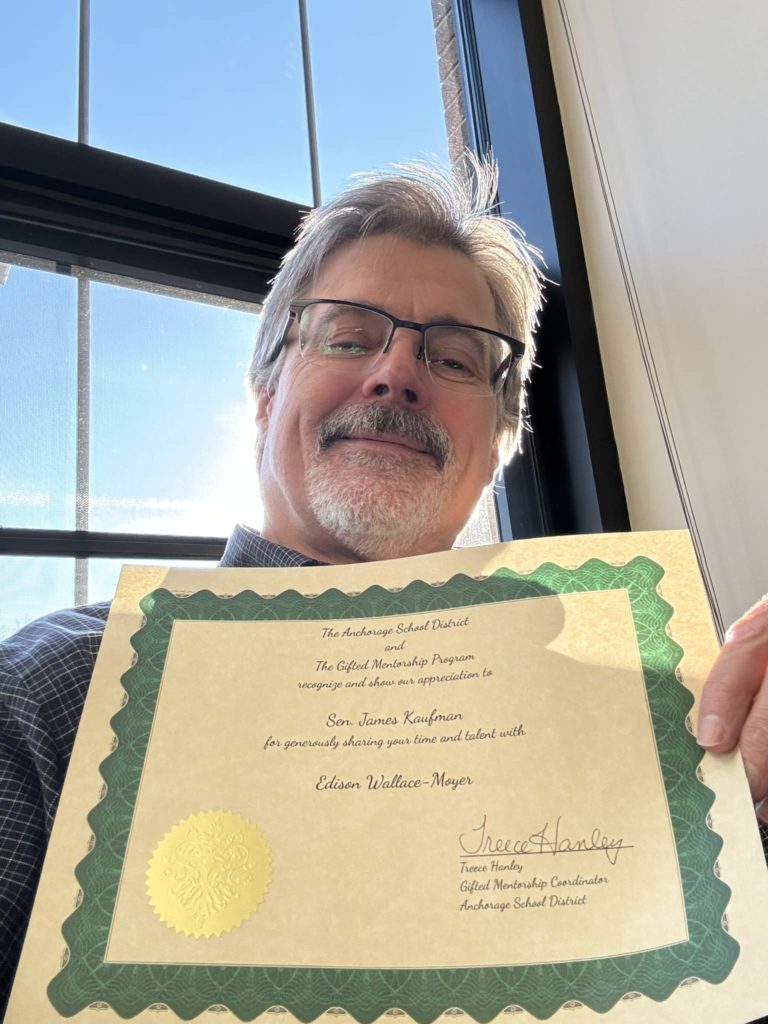
This session, I had the chance to mentor West High Junior, Edison Wallace-Moyer, through the Anchorage School District Gifted Mentorship Program. It is a fantastic program that helps connect young people directly with professionals in a variety of fields.
We’re looking forward to hosting another student next year!
Community Bulletin
📌 |
Abbott Loop Community Council MeetingThursday, April 25, 6:30-8:30PM |
📌 |
Hillside Home & Land Owners (HALO)Check online for meeting dates, 7:00PM Hillside Residents will have the opportunity to meet candidates running in the upcoming Municipal elections. The Forum will be held at the Alaska Zoo’s Community Room. |
📌 |
Hillside Community Council MeetingCheck online for the next meeting date, 6:30-8:30PM |
📌 |
Huffman/O’Malley Community Council MeetingThursday, May 16, begins 7:00PM |

